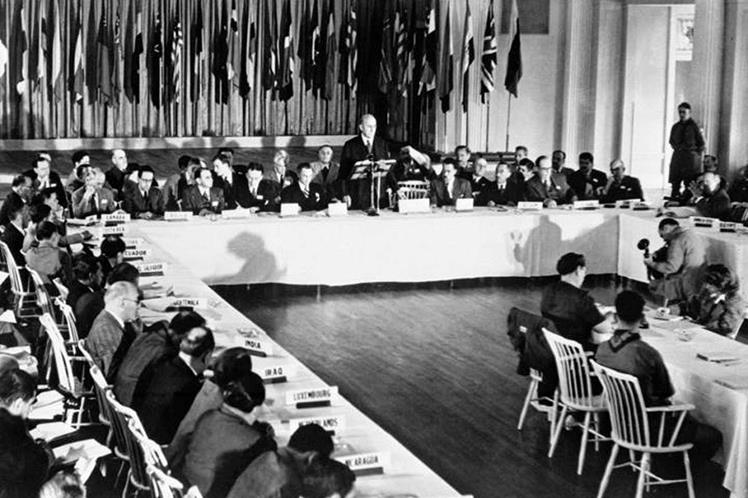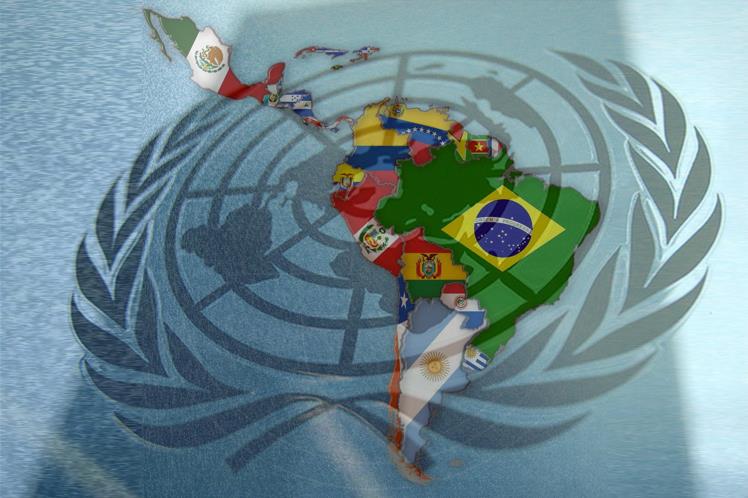By Juan Jose Paz and Miño Cepeda
It had the following purposes: promote and maintain peace in the world, cultivate friendly relations for the resolution of conflicts, protect human rights, economic development and respect for agreed international standards. In 1948, it proclaimed the Universal Declaration of Human Rights and there was a constant incorporation of new States until it currently reached 193 members.
Almost in parallel, the Bretton Woods Conference (1944) was the starting point of an attempt at economic globalization, albeit under the hegemony of the United States. The International Monetary Fund (IMF) and the International Bank for Reconstruction and Development (IBRD, known as the World Bank) were born there, all of which specified the prospects for coordination in two areas: monetary-financial and development.

It was more difficult to reach an agreement in the field of trade, although in 1948 the GATT (General Agreement on Tariffs and Trade) was established, operating de facto between the contracting parties for nearly half a century, although on a provisional basis and dealing exclusively with trade in goods.
The irregular functioning of the GATT led to the Uruguay Round (1986-1994), which gave rise to the World Trade Organization (WTO, 1995), thus consolidating a legally regulated world market for all members both in trade in goods and services and, additionally, in intellectual property. By 1997, 132 countries, virtually all Latin American countries, including Cuba, had joined the WTO.
On the other hand, as a result of the Bretton Woods agreements, the US-dollar was adopted as the currency for international exchange and savings. It was the consolidation of a system that had practically been functioning for years, when countries abandoned the “gold standard”, because it was sufficient to take the dollar as a reference, since the Federal Reserve (FR) retained the backing in gold (Gold Exchange Standard).

However, in 1971, under de Nixon administration, the US abandoned its gold standard. But that measure did not alter the hegemony of the dollar in international trade and financial relations.
Long before the creation of the UN and the Bretton Woods agreements, in the midst of US expansion, in May 1915, the Latin America countries were summoned to the First Pan-American Financial Congress held in Washington.
A large number of North American bankers and three representatives from each of these 18 countries participated: Argentina, Bolivia, Brazil, Chile, Colombia, Costa Rica, Cuba, Dominican Republic, Ecuador, El Salvador, Guatemala, Honduras, Nicaragua, Panama, Paraguay, Peru, Uruguay and Venezuela.
But these Monroist purposes failed to materialize. So, only after World War II did Latin America join the UN system, embracing its Charter and the Declaration of Human Rights and joining the institutions created by the Bretton Woods agreements.
In this context, the hegemony of the dollar has been unquestionable. Panama uses the dollar since it separated from Colombia (1903). Argentina adopted the “convertibility” of its currency with the dollar (1991). Ecuador dollarized its economy in 2000 and other countries in the region have maintained a de facto dollarization.
Unexpectedly, the war in Ukraine has altered international circumstances for the 21st century. The institutionality of the UN and a “world based on rules” did not stop the unjustified interventionism of the great powers in different countries.
There is a long history of US impositions, interventions, threats and sanctions on Latin American countries. So, since the dollar has been used as a political and economic tool to impose itself on the continent, the configuration of a new multipolar world in the 21st century, in which the rise of China, Russia, the BRICS and other regions stand out, what was considered the unbeatable hegemony of the dollar and the SWIFT system before the war has now also begun to change. This has been noticed by at least two relevant articles: that of Renaud Girard in Le Figaro and another by Peter C. Earle, of the American Institute for Economic Research (AIER).
It is clear that bilateral trade agreements to use national currencies (India, Iran, Dubai, Malaysia, Pakistan, Saudi Arabia) are growing, while Russia and China created their own payment system. The BRICS plan a common trustee currency, also moving away from the dollar; Brazil and China agreed to trade their currencies; Brazil and Argentina discuss common trustee currency.
And, in addition, a number of African countries plan to negotiate with backing in titles of rare earths or metals. So, in the US not only was there annoyance but also alarm. Because, although in the short term there is no predictable massive exit from the dollar, it is expected that this will happen in the long term and, according to the AIER, it is an inexorable path.
Is it possible?
Latin America is going to have to evaluate that uncertain economic future which would affect the dollar particularly in both the formally or totally “dollarized” countries.
In Ecuador, due to the pandemic, there were already spokesmen of the political right who considered inevitable the exit from the dollarization. The concern is openly in the business sector. And, that is the problem, because if the same neoliberal and oligarchic business model, recovered in 2017 and consolidated since 2021, continues in the future, a “de-dollarization” in the hands of right-wing governments would be carried out guaranteeing that the business elites do not lose anything, but at the expense of the majority of the population.
The country already has sufficient experience in this type of economic “solutions” with “Sucretization” (1983) and “Resucretization” (1987) -the use of the Sucre, Ecuador´s national currency- of private foreign debts, the million-dollar bank rescues and holidays (1999/2000), and the dollarization itself, which still remains due to a series of favorable results, at least for the moment.
On this basis, the “de-dollarization” which might be of concern in Latin America, in the hands of business-led governments, will surely only bring worse living and working conditions for its population.
jl/rmh/jjpmc









